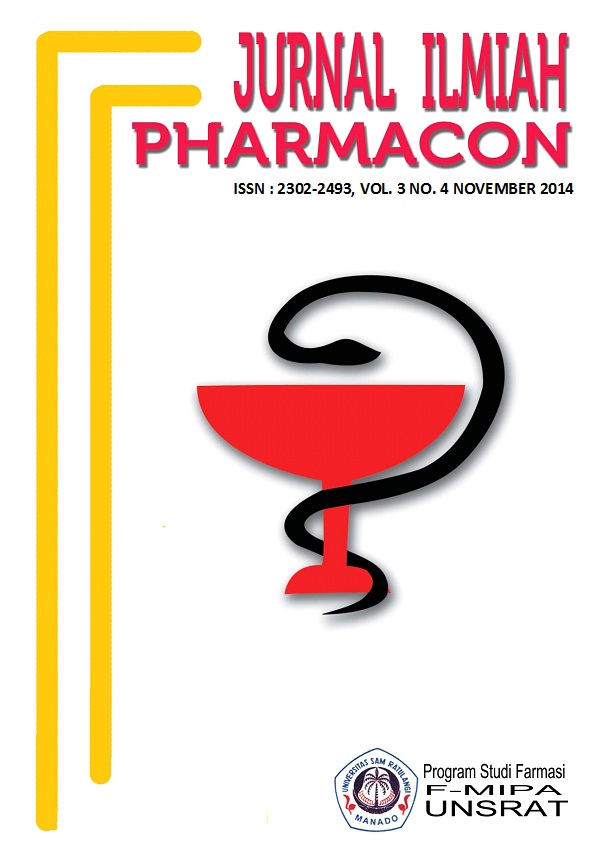6. FORMULASI DAN UJI EFEKTIVITAS SEDIAAN SIRUP EKSTRAK ETANOL DAUN WARU (Hibiscus tiliaceus L.) SEBAGAI ANTIPIRETIK TERHADAP TIKUS PUTIH JANTAN GALUR WISTAR YANG DIINDUKSI DENGAN VAKSIN DPT
DOI:
https://doi.org/10.35799/pha.3.2014.6045Abstract
Formulasi dan Uji Efektivitas Sediaan Sirup Ekstrak Etanol Daun Waru (Hibiscus tiliaceus L.) Sebagai Antipiretik Terhadap Tikus Putih Jantan Galur Wistar yang Diinduksi dengan Vaksin DPT
Mersi Molantong, Fatimawali, Hamidah Sri Supriati
Program Studi Farmasi, FMIPA UNSRAT Manado
Â
ABSTRACT
Waru leaves (Hibiscus tiliaceus L.) are used empirically by people to treat fever. This research aims to test the stability of the ethanol extract syrup of Waru leaves and its antipyretic effect on white male galur wistar rats after the fever was induced with DPT vaccine. Waru leaves ethanol extract syrup is made in three variations of the concentration of the active substance, they are 5%, 10%, 15% and stability test. The next test of the antipyretic effect is done by measuring animals rectal temperature using a digital thermometer. Result of stability testing on ethanol extract syrup of Waru leaves was homogenous with no precipitate is obtained that has bitter taste, the color is yellow with brown, as well as the characteristic of the smell, has a pH of 5-5,5. In testing antipyretic, ethanol extract syrup of Waru leaves concentration of 10% showed antipyretic effects while ethanol extract syrup of Waru leaves concentration of 5% and 15% did not. The conclusion of this research is that ethanol extract syrup of Waru leaves has good stability which is seen from homogeneity, organoleptic, and pH itself. Furthermore the antipyretic effects are shown by ethanol extract syrup of Waru leaves concentration of 10%, while concentration 5% and 15% did not.
Key words: Antipyretic, Hibiscus tiliaceus L., Syrup
ABSTRAK
Daun Waru (Hibiscus tiliaceus L.) digunakan secara empiris oleh masyarakat untuk mengobati demam. Penelitian ini bertujuan untuk menguji stabilitas sirup ekstrak etanol daun Waru dan efek antipiretiknya terhadap tikus putih jantan galur wistar setelah diinduksi dengan vaksin DPT. Sirup ekstrak etanol daun Waru dibuat dalam 3 variasi konsentrasi zat aktif yaitu 5%, 10%, 15% dan diuji Stabilitasnya. Selanjutnya dilakukan pengujian efek antipiretik dengan mengukur suhu rektal hewan uji menggunakan termometer digital. Hasil pengujian stabilitas sirup ekstrak etanol daun Waru ialah homogen dengan tidak diperolehnya endapan, memiliki rasa yang pahit, berwarna kuning kecoklatan, serta berbau khas, memiliki pH 5-5,5. Pada pengujian antipiretik, sirup ekstrak etanol daun Waru konsentrasi 10% menunjukan efek antipiretik sedangkan konsentrasi 5% dan 15% tidak memiliki efek antipiretik. Kesimpulan penelitian ini ialah sirup ekstrak etanol daun Waru memiliki stabilitas yang baik dilihat dari uji homogenitas, organoleptik, dan pH sediaan. Selanjutnya efek antipiretik ditunjukan oleh sirup ekstrak etanol daun Waru konsentrasi 10%, sedangkan konsentrasi 5% dan 15% tidak menunjukan efek antipiretik.
Â
Kata kunci : Antipiretik, Hibiscus tiliaceus L., Sirup
Â
Â
Â
Downloads
Published
How to Cite
Issue
Section
License
Authors who publish with this journal agree to the following terms:
- Authors retain copyright and grant the journal right of first publication with the work simultaneously licensed under a Creative Commons Attribution-NonCommercial 4.0 International License that allows others to share the work with an acknowledgement of the work's authorship and initial publication in this journal.
- Authors are permitted and encouraged to post their work online (e.g., in institutional repositories or on their website) prior to and during the submission process, as it can lead to productive exchanges, as well as earlier and greater citation of published work (See The Effect of Open Access)










